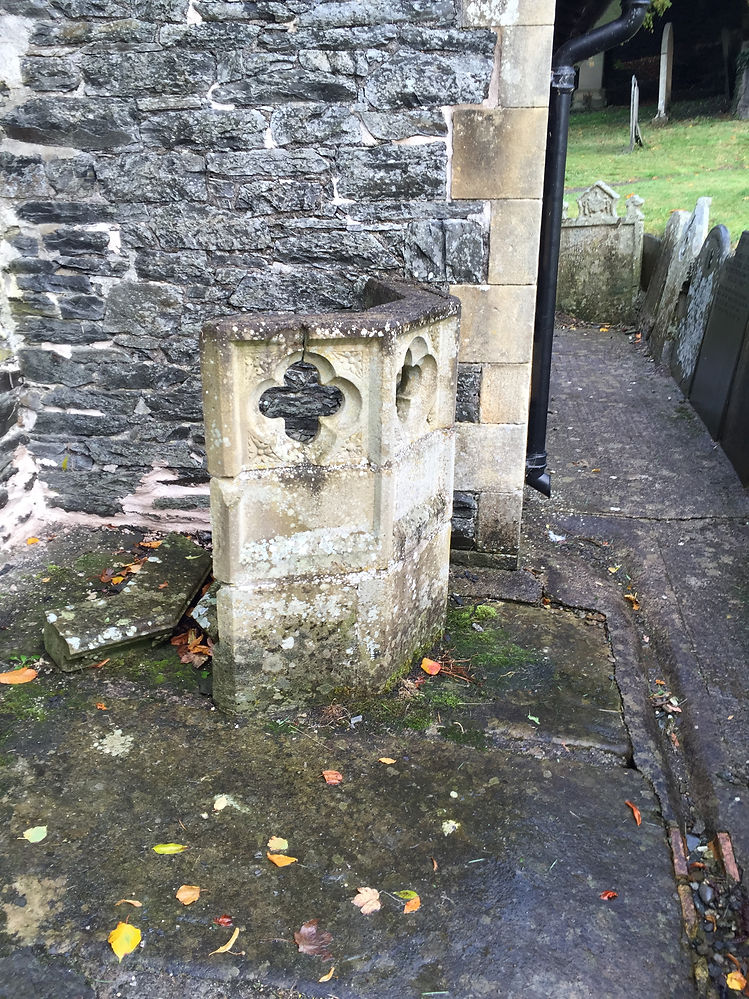
St Tysilio’s Church resides in a position of extraordinary beauty. Situated in its own little bit of heaven, not far from the River Dee and the Horseshoe Falls, its past is possibly ancient, based on its isolation and its dedication to the native St. Tysilio, an early 7th century bishop, a prince of Powys and scholar. The churchyard is clearly not curvilinear, which would have given some support to a pre-Conquest foundation.
Interestingly, St Tysilio would seem to have been a native of these parts, second son of the wonderfully named, Brochfael Ysgythrog (of the Tusks), King of Powys. A life of war was not for Tysilio, it seems, and he fled his birth right to secular power and threw himself on the mercy of Abbot Gwyddfarch at Caer-Meguaidd with a view to becoming a monk. This would not sit with the furious Brochfael Ysgythrog who, at the head of a warband, arrived at Caer-Meguaidd with a view to dragging Tysilio back to his responsibilities. His father, however, was persuaded to allow Tysilio to stay, and the young monk resided at Meifod and Welshpool, making the acquaintance of St Beuno.

It would seem the close proximity of his father’s court was a worry, however. Being a second son, there was, no doubt, a distinct possibility of Tysilio coming to the throne, especially given the fractured, warlike politics of the 7th century. Tysilio moved on, settling at an island that became known as Ynys Tysilio, now known as Church Island, connected to the island of Anglesey by a short causeway. From there, it is thought he preached to all parts of Ynys Mon for some seven years, before returning to Meifod where he became the Abbot and rebuilt the Abbey Church.
As perhaps might have been expected, Tysilio’s older brother, Cynan Garwyn died, possibly though probably not at the Battle of Chester in 613, making him next in line to the throne of Powys. Gwenwynwyn, his brother’s widow, wanted to marry Tysilio and place him on the throne of Powys. Refusing to do so, Meifod was placed under unbearable political pressure, and once again Tysilio fled, this time to Brittany, with its close ties to the native British. Eventually, he settled at Saint-Suliac (possibly one of the reasons he is often confused with St. Sulien), where he established a monastery. It is thought that he died there in 640.
St Tysilio’s today is a single naved church of the 15th century. It is claimed that there is masonry of the 12th century within its renovated fabric, which is not immediately clear. The lectern and roof are probably medieval and there are fragments of sepulchral slabs in the one window and some of the stained glass would seem to be 15th century. The east window is a stunning pre-Raphaelite, and in the nave a 1972 window by Trena Cox depicting the life of St Tysilio. There is a memorial to the poet Robert Browning who worshipped at the church during his 10 week visit to Bryntysilio Hall in 1886, just three years before his death, and a monument to Lady Martin of Bryntysilio, Helen Faucit in her acting days as a renowned Shakespearean actress, with masks of comedy and tragedy and a portrait medallion of Shakespeare upon it.
The churchyard is interesting, to say the least. For such a small village, it is certainly busy. The outside stone pulpit was thought to have been used for sermons in good weather, and probably was, since it looks up to an embankment upon which parishioners may have sat amongst the gravestones and listened to the service. It was not built for that purpose however, since it was removed from the interior in the 19th century when a wooden replacement was made. There are tombs to the great and good of Llantysilio, by which we mean Llantysilio Hall. Robert Jones is here, the man who for want of a will caused all manner of shenanigans for the Hall, as is C. F. Beyer, builder of the new Hall of 1872. Indeed, it is worth reading the article on Llantysilio Hall, since a haunting of the Church connects the two.

St Tysilio’s is in a wonderful setting, and enjoys stunning views of the Dee. The Llangollen railway runs along the south bank of the River Dee, and to stand in the churchyard and see the steam trains making their way to Corwen is to be transported to a different era. While it is possible to park by the lichgate, it is far more pleasant to make the short clearly signed walk from the Horseshoe Falls along the river.

